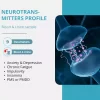- Your cart is empty
- Continue Shopping
‘All tests we do at FMD are aimed at finding the root cause of your health problem. These are not the usual diagnostic tests that you do, but much, much more.’
‘All tests we do at FMD are aimed at finding the root cause of your health problem. These are not the usual diagnostic tests that you do, but much, much more.’

₹7,999.00 ₹5,999.00
₹7,999.00 ₹5,999.00
Test Parameters:
Neurotransmitters are referred to as the body’s chemical messengers. They are the molecules used by the nervous system to transmit messages between neurons, or from neurons to muscles. Optimal neurotransmitter balance is required to maintain proper health. Imbalances can cause the brain and the body to be over- or under-stimulated, producing neurological or psychological symptoms.
 Reporting Time: 7 work days after sample received at lab.
Reporting Time: 7 work days after sample received at lab. Blood & Urine
Blood & Urine Best and Honest Price
Best and Honest Price1. Please let us know one day prior to taking the sample so that we can try and arrange the pickup next day.
2. Pickup of the sample may take 24-48 working hours depending on the location. The quality of the sample will not be compromised since it’s a dry sample. We try our best to arrange the pickup as soon as possible. In case it doesn’t happen or take time, you are requested to courier the same.
3. You may be required to take a printout of pickup label in case the label sent by us is more than 7 days old or we need to arrange pickup by different couriers.
Chronic Fatigue
An imbalance between excitatory and inhibitory neurotransmitters can lead to persistent fatigue.
Impulsivity
GABA, Dopamine and Serotonin are three chemical messengers commonly linked to disorders like ADD, ADHD & OCD. Insomnia Imbalances in Glutamate, Histamine, Dopamine, GABA and Serotonin are often linked to sleep disturbances and insomnia.
PMS or PMDD
Imbalances in Serotonin, Dopamine, Norepinephrine and GABA are often involved in cases of PMDD (pre-menstrual dysphoric disorder) and severe PMS.
* Please note this test will take 3 hours to complete.
Order an Neurotransmitters Test it is just a few simple step!
please enter the data where the Neurotransmitters set should be send
Detailed instructions and a return envelope you will find in the Neurotransmitters set
7 work days after sample received at lab Neurotransmitters analysis.
Neurotransmitters Test FAQ's Functional Medicine Diagnostic FAQ's
There are historical differences between the term “Asperger’s” and what’s considered “autism.” Asperger’s was first introduced into the Diagnostic and Statistical Manual of Mental Disorders (DSM) in 1994, and was considered as a “mild” or “high-functioning” form of autism.
This happened because English psychiatrist Lorna Wing translated the works of Austrian physician Hans Asperger and realized his research found distinct characteristics in autistic children from those with “milder” symptoms. However, as of 2013, Asperger’s is now considered part of the autism spectrum and is no longer diagnosed as a separate condition. The only real “difference” between the two diagnoses is that people with Asperger’s may be considered as having an easier time “passing” as neurotypical with only “mild” signs and symptoms that may resemble those of autism.
Conventional diagnosis involves finding out whether the child’s behaviour meets a set of criteria for autism or ADHD, based on a set of questionnaires.
Functional Medicine approach is to individualize each and every autistic child and find the root cause of the imbalance. Tests commonly advised are to assess gut microbiome. Functional testing can also look at toxic load, nutritional status, food sensitivities, mitochondrial function and genetic susceptibility to poor detoxification.
Our Working Process Healthcare model is shifting from Sickness care to Wellness.
Sample collection will be done from home

Sample is processed at Central Lab of our Trusted Partners.

Reports are accessible online.
Sample collection will be done from home

Sample is processed at Central Lab of our Trusted Partners.

Reports are accessible online.
Other Popular Test Packages Choose from our frequently booked test packages.